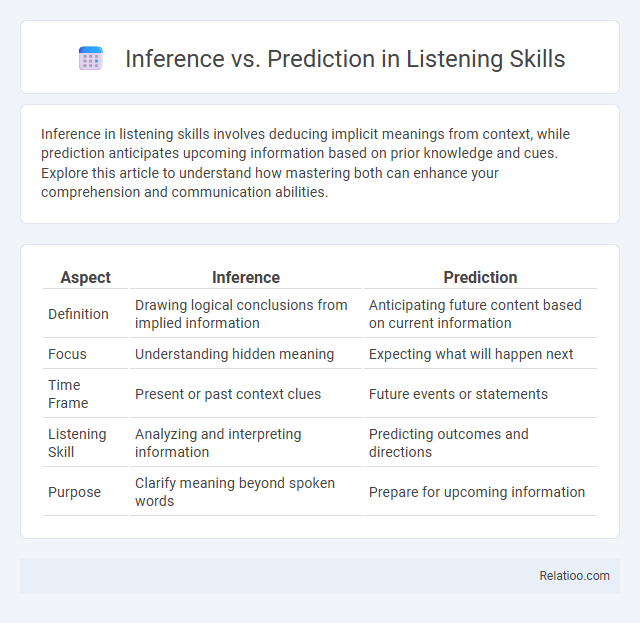Inference in listening skills involves deducing implicit meanings from context, while prediction anticipates upcoming information based on prior knowledge and cues. Explore this article to understand how mastering both can enhance your comprehension and communication abilities.
Table of Comparison
| Aspect | Inference | Prediction |
|---|---|---|
| Definition | Drawing logical conclusions from implied information | Anticipating future content based on current information |
| Focus | Understanding hidden meaning | Expecting what will happen next |
| Time Frame | Present or past context clues | Future events or statements |
| Listening Skill | Analyzing and interpreting information | Predicting outcomes and directions |
| Purpose | Clarify meaning beyond spoken words | Prepare for upcoming information |
Understanding Inference and Prediction in Listening
Inference in listening involves using contextual clues and background knowledge to interpret implicit meanings behind spoken words, enhancing comprehension beyond literal content. Prediction requires anticipating forthcoming information or content based on partial inputs, aiding active engagement and processing efficiency during listening. Mastery of inference and prediction skills significantly improves overall listening comprehension by enabling listeners to fill gaps and prepare for incoming information.
Key Differences Between Inference and Prediction
Inference in listening skills involves drawing logical conclusions from explicit and implicit information presented in the conversation, relying on contextual clues and background knowledge. Prediction anticipates future events or outcomes based on current information or patterns detected during active listening. The key difference lies in inference deducing meanings or intentions already embedded in the message, whereas prediction projects possible developments yet to occur.
The Role of Context in Making Inferences
Inference in listening skills relies heavily on contextual clues, enabling listeners to deduce meanings beyond explicit statements. Prediction, by contrast, involves anticipating future information based on current context and prior knowledge. The role of context is crucial in making accurate inferences, as it provides the background, tone, and situational cues necessary for understanding implied messages.
Predictive Listening: Anticipating Information
Predictive listening involves actively anticipating information based on contextual clues, prior knowledge, and linguistic patterns to enhance comprehension. Unlike simple inference, which is deducing meaning from given data, predictive listening enables listeners to forecast upcoming content, improving real-time understanding and response. This strategy is essential for effective communication, especially in dynamic or fast-paced auditory environments.
Why Inference Skills Matter in Comprehension
Inference skills enhance listening comprehension by enabling individuals to interpret implied meanings beyond the spoken words, filling gaps that are not explicitly stated. These skills allow listeners to connect context clues, tone, and background knowledge, resulting in a deeper understanding of conversations and lectures. Strong inference abilities improve critical thinking and the capacity to grasp nuances, essential for effective communication and learning retention.
Strategies for Teaching Prediction in Listening
Effective strategies for teaching prediction in listening focus on activating prior knowledge and using context clues to anticipate content. Incorporating pre-listening questions and vocabulary previews helps learners form hypotheses about the upcoming text, enhancing engagement and comprehension. Encouraging learners to make and revise predictions during listening fosters active processing and improves overall inferential skills.
Challenges Learners Face with Inference
Learners often struggle with inference in listening skills because it requires understanding implicit meanings and connecting contextual clues rather than just processing explicit information. Your ability to infer depends on recognizing tone, speaker intention, and cultural nuances, which can be challenging without sufficient background knowledge or vocabulary. These difficulties make inference a more demanding cognitive process compared to straightforward prediction in listening tasks.
Assessing Inference and Prediction Abilities
Assessing inference and prediction abilities in listening skills involves evaluating how well individuals extract implicit meaning and anticipate upcoming information based on auditory cues. Effective assessment focuses on tasks that require listeners to interpret context, identify implied ideas, and forecast content accurately, reflecting their comprehension depth and cognitive engagement. Tools such as targeted listening exercises and scenario-based questions provide measurable insights into the development of these critical auditory processing skills.
Real-Life Examples in Listening Exercises
Inference in listening skills involves drawing conclusions from contextual clues and tone, such as understanding sarcasm in a conversation, whereas prediction requires anticipating upcoming information based on prior knowledge, like guessing the next topic in a lecture. Real-life listening exercises that hone inference include interpreting implied emotions in dialogues or news reports, while prediction-focused tasks might involve forecasting answers in interviews or completing storylines in podcasts. Mastery of both inference and prediction enhances comprehension by enabling listeners to process implicit meanings and anticipate content effectively.
Enhancing Listening Skills Through Practice
Enhancing listening skills through targeted practice involves distinguishing between inference and prediction, where inference requires interpreting implicit meanings based on context, and prediction involves anticipating upcoming information. Effective listening exercises that emphasize both inference and prediction improve comprehension by training the brain to connect clues and forecast content dynamically. Regular engagement with varied audio materials sharpens the ability to infer speaker intent and predict dialogue flow, leading to more active and accurate listening outcomes.

Infographic: Inference vs Prediction in Listening Skills
 relatioo.com
relatioo.com